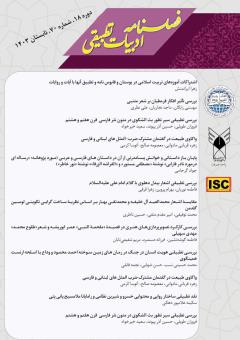واکاوی طبیعت در گفتمان مشترک ضربالمثلهای لبنانی و فارسی
محورهای موضوعی : شعر
زهره قربانی مادوانی
1
*
![]() ,
معصومه صالح
2
,
آتوسا کرمی
3
,
معصومه صالح
2
,
آتوسا کرمی
3
1 - دانشگاه علامه طباطبائی
2 - دانشگاه علامه طباطبائی
3 - علامه طباطبائی
کلید واژه: ایران, ضرب المثل, طبیعت, فرهنگ, فولکلور,
چکیده مقاله :
از آنجا که ضربالمثلها یکی از مقولههای زبانی بسیار مهم هر ملت را تشکیل میدهند و علاوه بر این نمای کاملی از فرهنگ و آداب و رسوم و عقاید یک ملت هستند، از اهمیت ویژهای برخوردار هستند و مقوله مهمی در مطالعات زبانشناسی و ادبیات به شمار میروند.ضربالمثلها در ادبیات ملل مختلف از جایگاه ویژهای برخوردارند تا جایی که بخش مهمی از ادبیات هر جامعه را دربرگرفتهاند و بررسی آنها منجربه کشف اشتراکات و اختلافات فرهنگی آنها میشود و نشانه دغدغه فکری گذشتگان و دارای پند و اندرز است. زبانهای فارسی و عربی در طول تاریخ همواره تاثیرات بسیاری بر هم داشتهاند و این تاثیرات و مبادلات فرهنگی گاها باعث ایجاد اشتراکات زیادی بین این دو زبان شده است. این مقاله سعی دارد به روش توصیفی تحلیلی ضربالمثلهای با مفهوم مشترک بین این دو زبان را از نظر جایگاه عناصر طبیعی در آنها مورد بررسی قرار دهد. نتایج این مقاله حاکی از آن است مثلهای فارسی و لبنانی در به کارگیری عناصر طبیعی زمینی دارای مشترکات بسیاری هستند علت این امر به موقعیت جغرافیایی، بافت فرهنگی و تاریخی و بینش مشترک دو ملت باز میگردد. اما در عین حال ضربالمثلهای لبنانی در مقایسه با ضربالمثلهای فارسی گرایش بیشتری به عناصر طبیعت به ویژه حیوان و سنگ داشته است. از دیگر نقاط مشترک آنها، اینکه هر دو زبان در بیان مثلهای خود در بهکارگیری حیوانات به استقامت آنها، غریزه و جثهشان توجه داشتهاند اما در دیگر عناصر همچون کوه، سنگ و آب صرفا خود واژگان مدنظر بودهاند.
Proverbs are of special importance since they are one of the most important linguistic categories of any nation and a complete view of the culture, customs and beliefs of a nation, and important category in the study of linguistics and literature. Proverbs have a special place in the literature of different nations to the extent that they cover an important part of the literature of any society and their study leads to the discovery of their cultural commonalities and differences and is is a sign of the intellectual concern of the past and has advice. Persian and Arabic languages have always had many influences throughout history, and these influences and cultural exchanges have sometimes led to many similarities between the two languages. This article tries to examine the proverb with a common meaning between these two languages in terms of the place of natural elements in them in a descriptive-analytical method. The results of this article indicate that Persian and Lebanese proverbs have many commonalities in the use of natural terrestrial elements. The reason for this is due to the geographical location, cultural and historical context and the common vision of the two nations. But at the same time, Lebanese proverbs have a greater tendency towards the elements of nature, especially animals and stones, compared to Persian proverbs. Another common point is that both languages, in expressing their proverbs in the use of animals, have paid attention to their endurance, instinct, and body, but in other elements, such as mountains,

